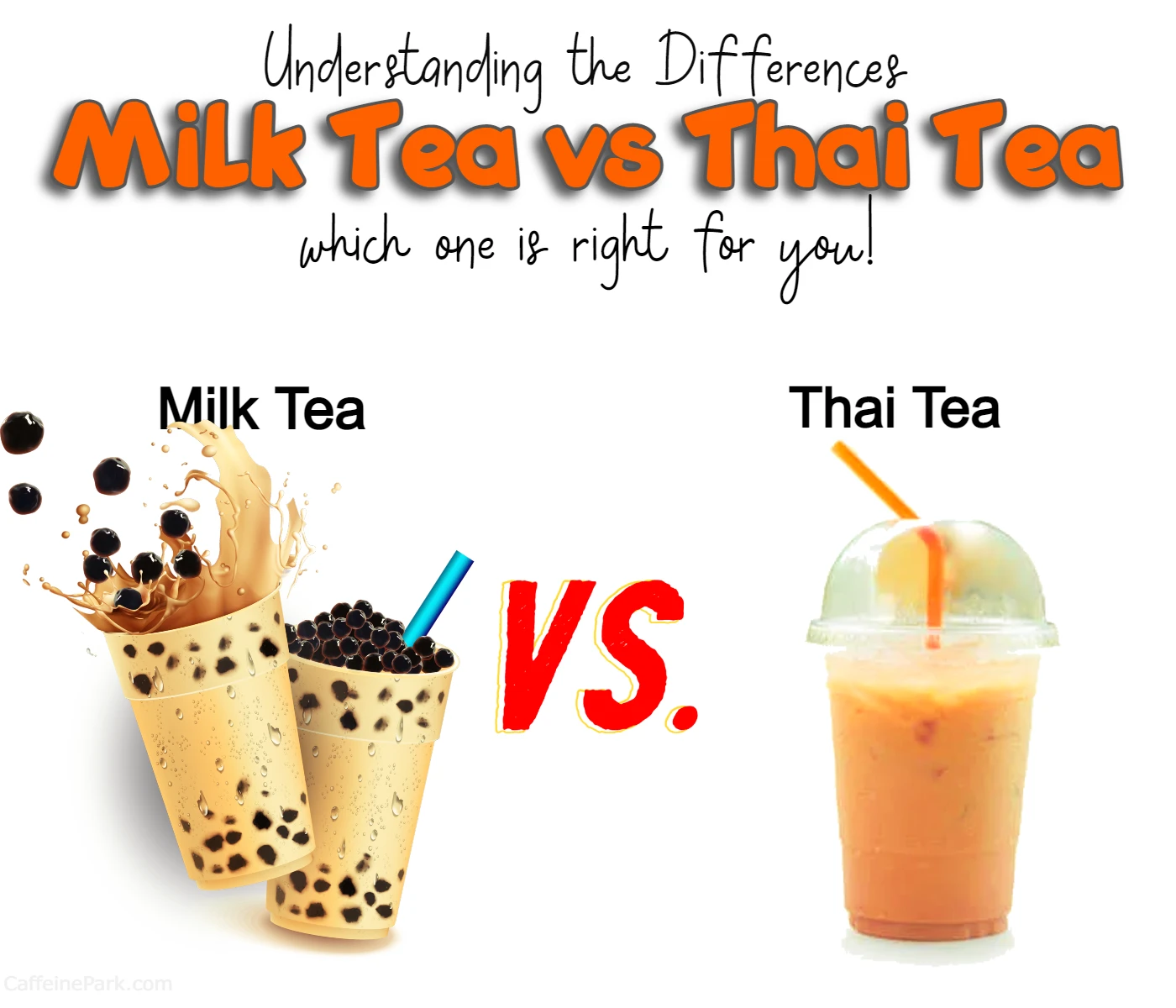
Are you a fan of tea-based beverages but unsure about the differences between milk tea and Thai tea? Look no further! In this blog post, we’ll explore the key differences between these two popular drinks, from their ingredients to their flavor profiles.
Milk tea, also known as bubble tea or boba tea, is a Taiwanese tea-based drink that has become incredibly popular in recent years. It’s typically made with black tea, milk, and sweeteners like sugar or honey. Milk tea is often served with chewy tapioca pearls, known as boba, which add a fun and unique texture to the drink. You can also find milk tea in a variety of flavors, such as matcha, taro, or fruit-infused.
Thai tea, on the other hand, is a sweet and creamy tea beverage that originated in Thailand. It’s made with a blend of black tea, spices like cardamom and cloves, and sweetened condensed milk or evaporated milk. This gives Thai tea a rich and creamy texture that sets it apart from milk tea. Thai tea is often served over ice and can be found at many Thai restaurants or specialty tea shops.
If you’re curious about which tea is right for you, keep reading! We’ll dive deeper into the differences between milk tea and Thai tea and help you decide which one is best for your taste buds. So, grab a cup of tea, and let’s get started!
here’s a quick chart outlining some of the key differences between milk tea and Thai tea:
| Milk Tea | Thai Tea | |
|---|---|---|
| Tea Base | Black tea | A blend of black tea and spices |
| Sweeteners | Sugar, honey, or flavored syrups | Sweetened condensed milk or evaporated milk |
| Flavor | Strong tea flavor with added sweetness | Sweet and creamy with a unique spice profile |
| Toppings | Chewy tapioca pearls (boba) | None or occasionally jelly or fruit bits |
| Caffeine content | Can contain more caffeine (151mg per 16 oz) | Typically contains less caffeine (47mg per 8 oz) |
Keep in mind that the specific ingredients and preparation methods can vary depending on the recipe and location. It’s always a good idea to check with the vendor or read the nutrition information before consuming.
Introduction Thai tea vs Milk tea
What is Milk Tea?
First, let’s talk about milk tea. Milk tea, also known as boba tea or bubble tea, is a popular drink that originated in Taiwan in the 1980s. It is made by mixing black tea, milk, sugar, or other sweeteners. The tea is often served with chewy tapioca balls, also known as boba, which adds a unique texture to the drink.
Milk tea has become incredibly popular all around the world, with many different variations and flavors. Some people prefer their milk tea with more milk than tea, while others prefer a stronger tea flavor. Some popular flavors include taro, matcha, and fruit flavors such as strawberry or peach.
What is Thai Tea?
Now, let’s move on to Thai tea. Thai tea, also known as cha yen, is a sweet and creamy tea that originated in Thailand. It is made by brewing black tea with spices such as star anise, cardamom, and cloves, and then adding condensed milk or evaporated milk and sugar. The tea is usually served over ice and sometimes topped with a splash of cream.
Thai tea is famous for its distinctive orange color, which comes from the addition of food coloring. Some variations of Thai tea include the addition of coconut milk, which gives it a richer and creamier taste.
Differences between Milk Tea and Thai Tea
Ingredients
The main difference between milk tea and Thai tea lies in the ingredients used to make them. While both teas contain milk and sugar, the types of tea and additional flavorings used are different. Milk tea uses black tea, while Thai tea uses a blend of black tea and spices such as star anise and cardamom. Thai tea also uses food coloring to achieve its signature orange color.
Caffeine Content
Milk tea and Thai tea can vary in their caffeine content depending on the specific recipe and the type of tea used. Generally, milk tea made with black tea contains more caffeine than Thai tea, which typically uses a blend of black tea and spices.
A typical 16-ounce serving of milk tea can contain anywhere from 151 milligrams of caffeine, depending on the strength of the tea used. A typical 8-ounce serving of Thai tea can contain around 47 milligrams of caffeine.
Flavor
Another difference between the two teas is their flavor. Milk tea has a creamy and sweet flavor, while Thai tea has a more complex flavor profile due to the addition of spices. Thai tea also has a distinct sweetness that comes from the use of condensed milk or evaporated milk.
Texture
Milk tea and Thai tea also differ in their texture. Milk tea usually contains chewy tapioca balls, which give the drink a unique texture. Thai tea, on the other hand, is usually served over ice, making it a more refreshing and cooling drink.
Origin
Finally, milk tea and Thai tea have different origins. Milk tea originated in Taiwan in the 1980s, while Thai tea originated in Thailand. Each drink has its unique cultural significance and is often enjoyed in different ways depending on the region.
Conclusion
In conclusion, both milk tea and Thai tea are delicious drinks that offer different flavor profiles, textures, and cultural significance. Whether you prefer the creamy sweetness of milk tea or the complex flavors of Thai tea, both drinks are sure to delight your taste buds. So why not give them both a try and see which one you prefer?
Alternative to milk tea and Thai tea
If you’re looking for an alternative to milk tea and Thai tea, there are plenty of other delicious tea-based drinks to try. Here are a few options:
- Matcha Latte: Made with finely ground green tea powder and steamed milk, matcha lattes are a creamy and flavorful alternative to traditional milk tea.
- Chai Tea Latte: Chai tea is made with black tea and a blend of spices like cinnamon, ginger, and cardamom. When combined with steamed milk, it creates a fragrant and spicy latte that’s perfect for cozy afternoons.
- Iced Tea: If you’re looking for a refreshing and low-calorie option, iced tea is a great choice. You can make it with black tea, green tea, or herbal blends, and add your favorite fruits or herbs for a burst of flavor.
- Herbal Tea: Herbal teas are made with dried flowers, herbs, and spices, and are naturally caffeine-free. They come in a variety of flavors, from calming chamomile to invigorating peppermint.
- Fruit Tea: Fruit teas are made with a base of black or green tea, and are infused with real fruit flavors like peach, raspberry, or strawberry. They’re sweet and refreshing and perfect for warm weather.
No matter what your taste preferences are, there’s a tea-based beverage out there for everyone. Give these alternatives a try and see which one becomes your new favorite!
FAQs
Thai tea is generally sweeter than milk tea due to the use of condensed milk or evaporated milk in its recipe.
Milk tea usually has more caffeine than Thai tea since it is made with black tea, which contains more caffeine than the blend of black tea and spices used in Thai tea.
Yes, you can add boba to Thai tea. However, it is not as common to add boba to Thai tea as it is with milk tea.
Yes, you can make milk tea with Thai tea leaves. However, the resulting flavor will be different from traditional milk tea since Thai tea leaves have a different blend of spices and may contain food coloring.
Both milk tea and Thai tea contain sugar and calories, so they should be enjoyed in moderation. However, Thai tea may have more antioxidants due to the addition of spices such as cardamom and cloves.
Read More:





